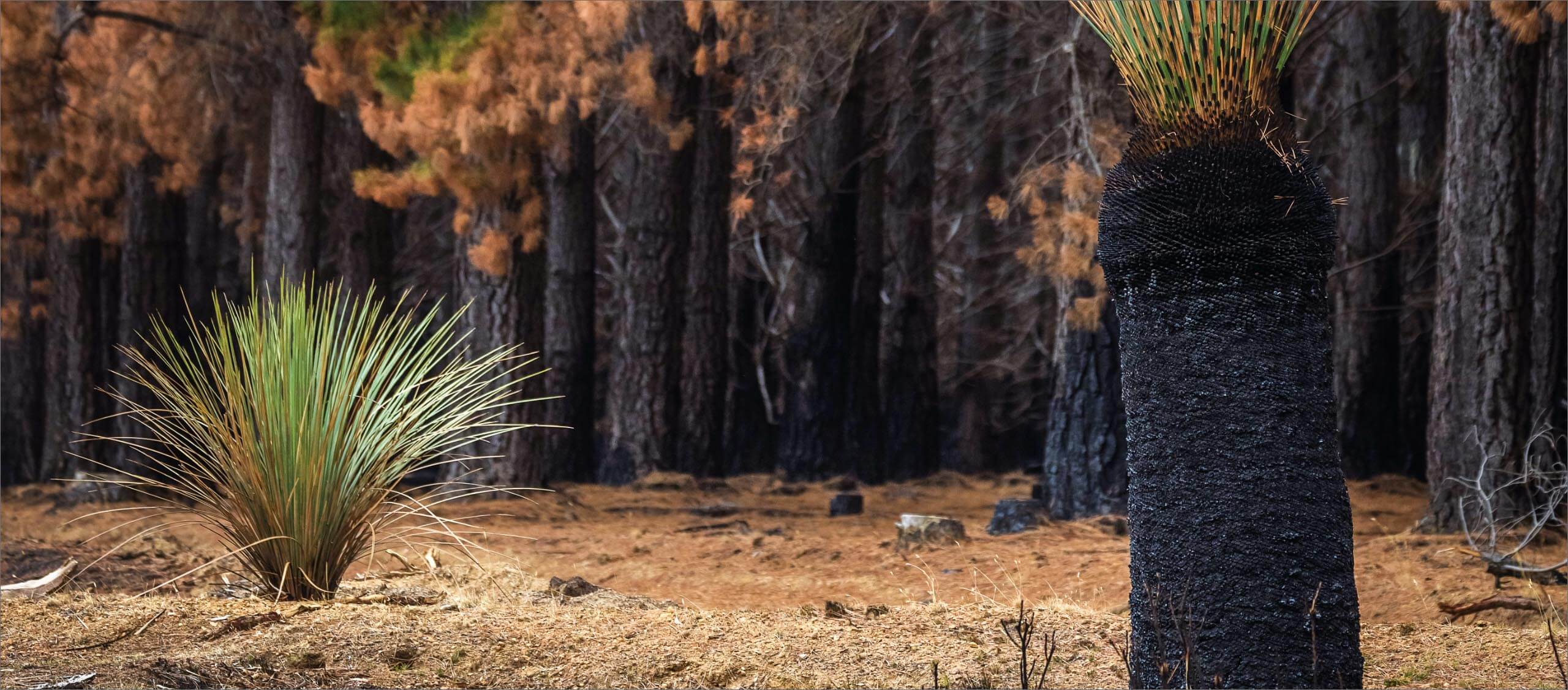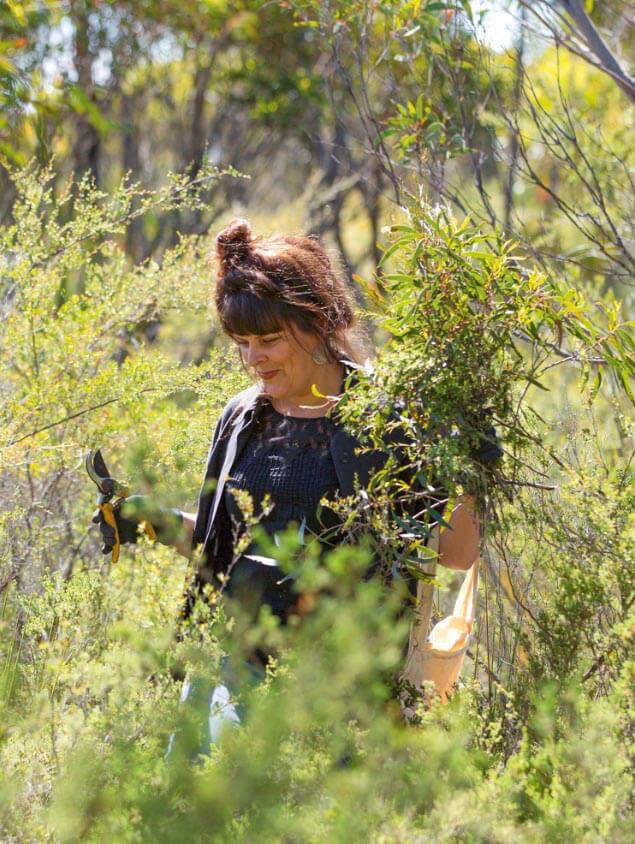
Hard yacca
A century of harvesting and exporting the resin of grass tresss on Kangaroo Island, SA, is coming to an end.
Story: Sarah Harris
When Wes and Rita Hurrell bought an old sheep farm as part of their dairy diversification plan, they landed a special bonus thanks to four generations of careful stewardship.
The high rainfall country in the Mount Lofty Ranges on the southernmost tip of the Fleurieu Peninsula, SA, boasts several magnificent stands of Tate’s grass trees or yacca.
‘We have mass groupings of them, including some with gum trees and really, really gnarly ones with two or three heads,’ Rita explains as she bumps uphill in the champion Holstein breeder’s ute. ‘The boys think they are a bit of a pain, but I just love them, so do the birds, and the cows like to rub their heads against the trunks of the big ones.’
The most impressive of these is more than 3m tall. As they grow just 1cm a year, they are up to three centuries old. It is unusual to find so many towering mainland examples of this plant outside conservation areas, with many of the oldest grass trees destroyed by early land clearing and during the harvest of resin.
The Tate’s grass tree is one of 28 species of Xanthorrea found only in Australia. Sometimes described as a living fossil, it is somewhat confusingly neither grass nor tree, but a prehistoric relative of the lily, with a hollow trunk formed by old leaf bases cemented by resin.
Endemic to Kangaroo Island and the southern reaches of the Fleurieu, the yacca produces striking flower spikes and has long been prized by Indigenous Australians. The Ramindjeri people used the dried flower stems as fire drills as well as lightweight spear shafts, harvested roots and nectar for food, and also collected the ruby red resin, which they used for waterproofing and as the world’s first superglue. White settlers quickly recognised the value of the resin and it became the basis of a small, but highly profitable export trade.

Above: Janine Mackintosh uses yacca gum and other local plants in her art.
Yacca-gumming was the name given to the little-known industry which, at its peak in the 1920s, saw more than 2500 tonnes of yacca gum resin exported to Europe each year. Sold first as lumps and granules, and later ground into a fine orange powder known as accroides, the fragrant resin was used in everything from church incense and soap to boot polish, wood stain, in the manufacture of gramophone records and even as light-absorbing paint for darkrooms.
George Turner was the last of the ‘yacca kings’ to earn his living from gumming, with a gang of four working for him. Now 77, George literally wrote the book on the subject, producing The History of Yacca Gumming on Kangaroo Island in 1994.
The industry hit its peak in 1929. ‘By then, there were several hundred men all out in the scrub gumming,’ George says. ‘There really were men in the scrub everywhere with axes.’ As he can attest, it was indeed hard yakka. ‘They say shearing sheep is hard work, but yacca gumming was a lot harder, but the money was just as good if not better … If someone turned up in a brand new FJ ute you could bet it was from yacca money.’
Working from sun up to sun down in bush camps for weeks at a time, the yacca-gummers cut off the head of the plant and set to work on the trunk, cutting away the resin at the base of the leaf butts. This was then winnowed through a converted harvester to separate the granules of resin for bagging.
Resin was for some years Kangaroo Island’s number-one export. Manifests show exports from Kingscote Jetty for 1914 included 190 bales of wool, 463 tons of yacca gum, 43 cattle, 3950 sheep and 921 packages of eucalyptus oil.
‘It was good business for everyone who did it,’ says George, who gummed for 30 years. ‘We would do a ton a day and used to sell it for $200 a ton, but toward the end we made it into a powder-like cement and we got $2000 a ton.’
For Kangaroo Island artist Janine Mackintosh, the red resin of the iconic yacca speaks of the blood of the land and ecological casualties caused by clearing after World War II. This idea is powerfully expressed in her work Southern Loss, which comprises six stars made of sheep’s vertebrae lacquered with yacca gum arranged on fencing wire.
‘I think of the paddocks as a battlefield,’ she says. ‘The soldiers who had been at the Second World War returned home after those battles and were then asked to go out and battle the bush to create sheep pasture. It was an incredibly difficult time for them and some of the land they were assigned really wasn’t that suitable for farming.’
The fires that razed half of Kangaroo Island in the summer of 2019–20 did not discriminate between farmland or bush, livestock or native animals. And from the charred, scarred landscape that saw 96% of Flinders Chase National Park destroyed, it was the highly flammable yacca that offered the first green shoots of hope.
‘The yacca growth is phenomenal,’ National Parks and Wildlife Service manager on Kangaroo Island Mike Greig says. ‘The flower spikes are 4–5m long and multiple on some plants. Even long-time islanders say they have never seen the like. The yaccas are first responders after fire and the flowers put vital energy back into the ecosystem as a food source for birds and insects.’
The plants have grassy skirts that provide habitat for scores of creatures, including wrens, lizards and small mammals such as dunnarts and the yellow-footed antechinus. Dried Tate’s yacca flower stalks are particularly important nesting sites for the endangered green carpenter bee.
Attitudes to the yacca have really come full circle since the Federal Government all but put an end to gumming in the 1990s. ‘I think it is good that we still have yaccas on show, that they have not all disappeared,’ George says.
Even as early as 1909 it was recognised as a finite resource, with one newspaper correspondent writing, ‘the only regrettable feature is that the industry is of necessity a diminishing one, but it is safe to say many years will elapse before the vast territory of yacca scrub will be stripped of its valued possession’.
Today, there is just one remaining licence to harvest this protected species, and resin collection is restricted to dead stumps of yacca found on private land on Kangaroo Island. The Commonwealth-approved ‘wildlife trade operation’ licence is held by one of Australia’s largest import-export agribusinesses, the Perth-headquartered Craig Mostyn Group.
The company has been involved in the yacca-gum trade since the 1940s, when the gummers realised they were not getting the best deal from their original agent and switched. The company confirms it holds authority to harvest yacca resin on Kangaroo Island as ‘a small-scale, approved wildlife trade operation’. The resin is exported by the Victorian-based Craig Mostyn Protein Trading Division to European buyers who use it in production of fireworks. Accroides is still being widely advertised for sale on the internet for $90–120/kg, but it is believed none has been exported since the fires.
Steve Hall, chemist and founder of the UK-based company Inoxia, has sold 39kg of KI yacca resin to pyrotechnics makers in the past year. ‘We were kind of lucky we bought a large amount of stock in 2019,’ he says. ‘It is used as an organic fuel because it can burn without putting much colour in the flame.’
The reason that European fireworks manufacturers continue to use yacca gum sourced only from one species of tree on a tiny island on the other side of the world is simply because they can. ‘Pyrotechnics isn’t really cutting-edge technology,’ Steve says. ‘From what I understand, they tend to focus on combining effects rather than messing with individual formulations. If you have a tried and true formulation, you tend to sort of stick with it.’
But with only one year left on the sole remaining harvest licence, it seems after almost 170 years the historic industry of yacca-gumming will finally fizzle out.
This story is from OUTBACK Magazine: Feb/May 2021 Issue #135